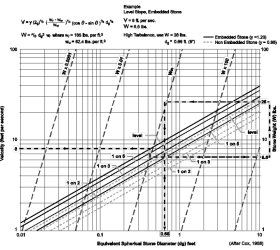F.3.1
Research by the US Army Corps of Engineers has provided criteria for selecting the median stone weight, W50 (see Figure F.17). If the riprap is to be used in a highly turbulent zone (such as at a culvert outfall, downstream of a stilling basin, at sharp changes in channel geometry, etc.), the median stone W50 should be increased from 200 percent to 600 percent depending on the severity of the locally high turbulence. The thickness of the riprap layer should generally be twice the median stone diameter (D50) or at least that of the maximum stone. The riprap should have a reasonably well graded assortment of stone sizes within the following gradation:
1.25 ≤ Dmax/D50 ≤ 1.50
D15/D50 = 0.50
Dmin/D50 = 0.25
Detailed design methodology may be found in Hydraulic Design of Flood Control Channels (Army Corps 1991). For a more detailed analysis and design procedure for riprap requiring water surface profiles and estimates of tractive force, refer to Maynord et al. (1989).
Figure F.17. Mean Channel Velocity vs. Medium Stone Weight and Equivalent Stone Diameter.
